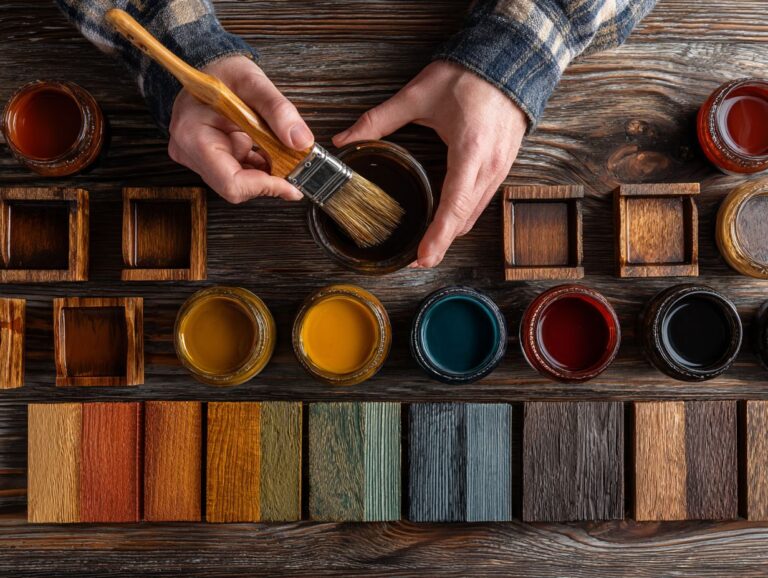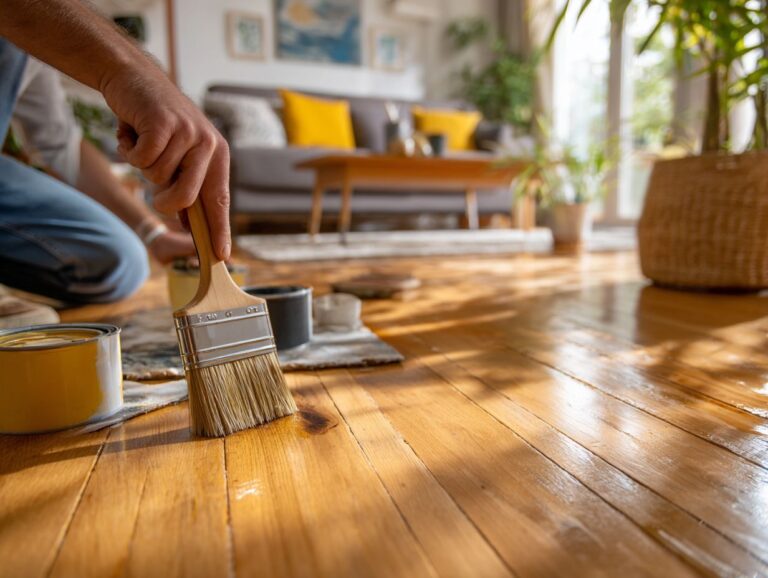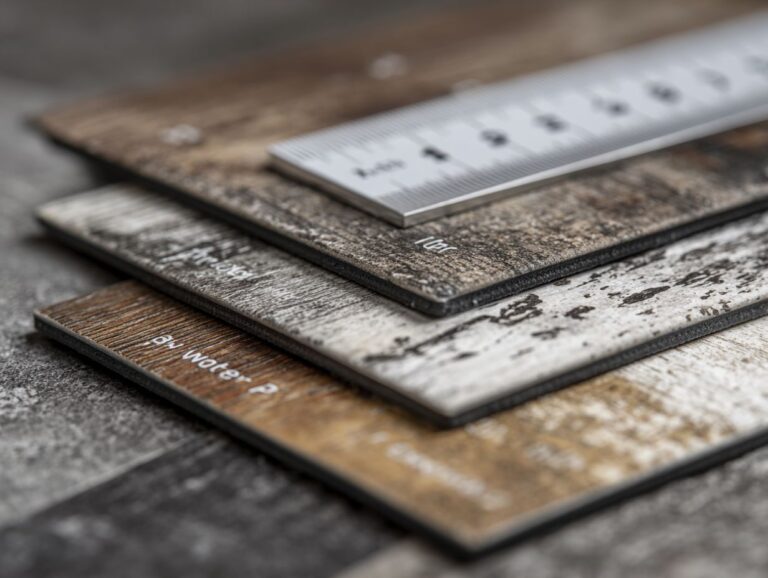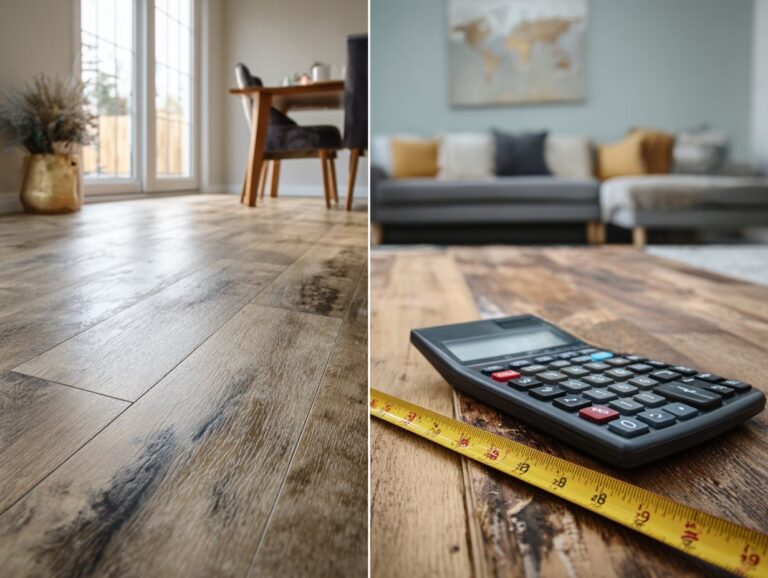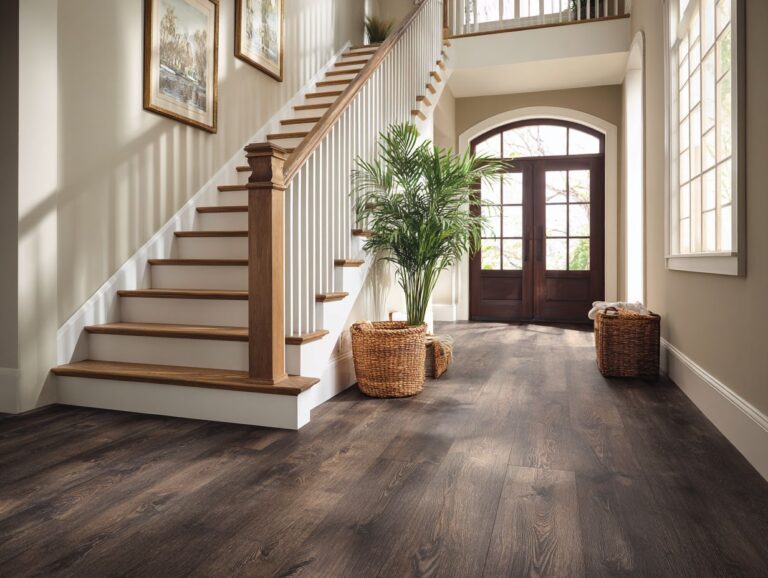Retro Flooring Comebacks – What’s Old is New
Look back at history with retro flooring, featuring classic designs like Art Deco and medieval interiors that are becoming popular again. According to flooring expert Alex Heslop at Flooring Superstore, these nostalgic designs are shaping today’s interior trends. This article discusses the comeback of old-style flooring options and shows how traditional designs can improve contemporary spaces. Learn about the charm of past times and how to bring these beautiful styles into your home.
Key Takeaways:
Contents
Definition of Retro Flooring
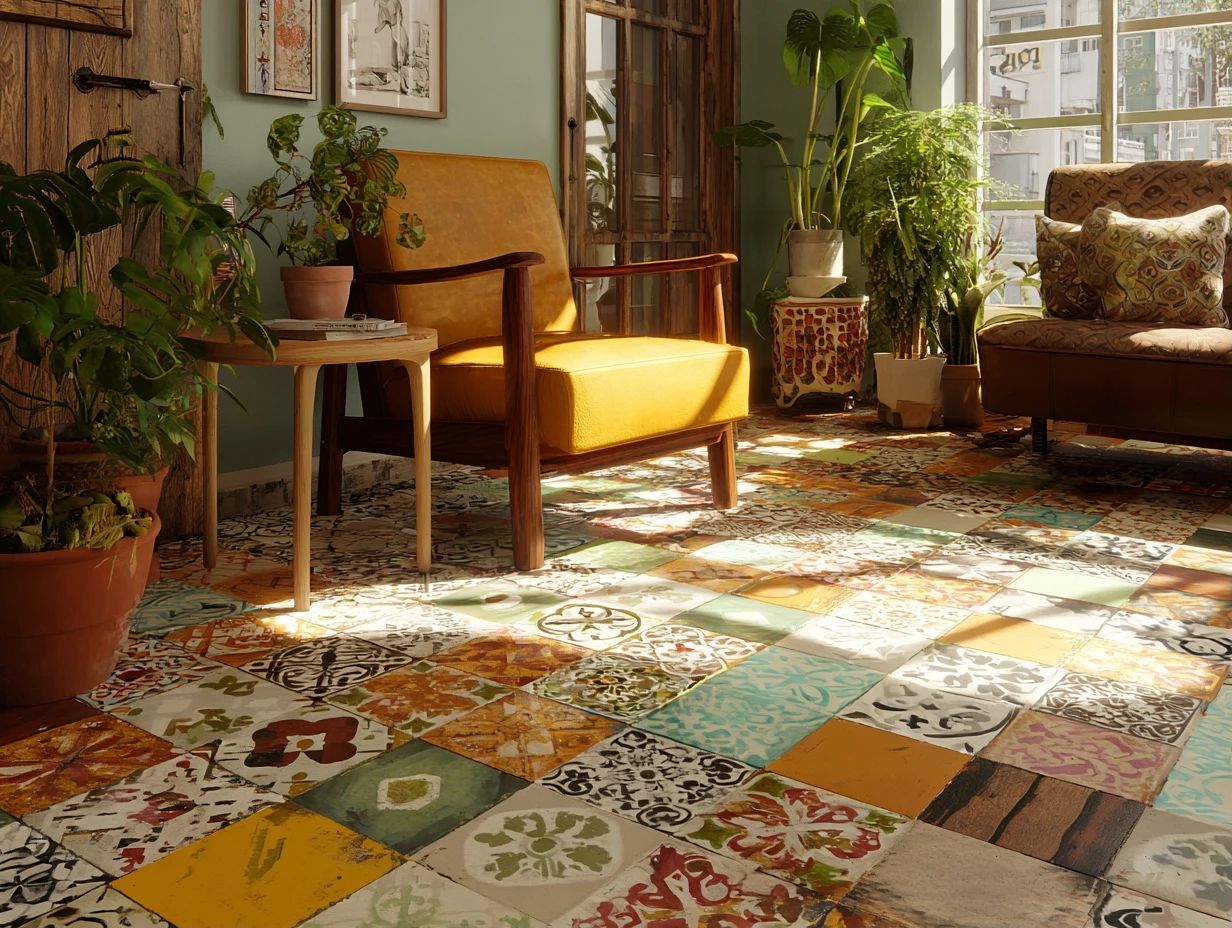
Retro flooring includes styles and materials that bring back historical design, using elements from different times such as Art Deco and medieval interiors.
Popular materials for retro flooring include vinyl, cork, and hardwood, each offering unique characteristics that reflect different eras.
For instance, vinyl offers vivid patterns reminiscent of the 1960s, while cork adds a natural warmth common in mid-century designs. Hardwood floors, especially those with a distressed finish, reflect a farmhouse aesthetic popular in earlier American homes.
Pair these flooring options with vintage decor or modern furniture to create a nostalgic yet contemporary atmosphere, showcasing how retro styles can seamlessly work together with today’s interior trends.
Importance of Flooring in Home Design
Flooring is a key part of home design, affecting how it looks and feels, as well as how long it lasts and how easy it is to use.
Choosing the right flooring shapes areas and improves the feel of the home. For instance, hardwood floors add warmth to living areas, while tile can create a crisp, clean look in kitchens and bathrooms.
Textures like carpeting can soften a space and improve acoustics. According to recent surveys, 70% of homeowners regard flooring as a critical element in their design decisions.
When selecting flooring, think about durability, upkeep expenses, and how it affects the environment to make sure it suits your way of living and design goals.
Historical Overview of Flooring Trends
Looking at past flooring trends shows changes in design choices, highlighting how some styles have reappeared with modern updates. Such trends often influence financial decisions, particularly in home renovations, where understanding which flooring upgrades pay off can be crucial.
1970s Flooring Styles
In the 1970s, flooring featured striking designs with hexagon and checkerboard tiles becoming popular options.
These tiles commonly showed bright colors such as orange, avocado green, and mustard yellow, reflecting the style of the time. Popular materials included vinyl, which offered affordability and easy maintenance, as well as shag carpets that provided comfort and warmth to living spaces.
To recreate the 70s aesthetic today, consider using modern vinyl tiles with similar patterns or opting for plush rugs in earthy tones. Online stores like Wayfair and Overstock offer various retro-style items, making it easy to bring a vintage look to modern homes.
1980s and 1990s Influences
The 1980s and 1990s saw the rise of luxury vinyl tiles, which combined affordability with retro aesthetics, shaping the modern vintage modern movement.
These tiles offered homeowners a durable, water-resistant option that mimicked traditional materials like wood and stone. Brands like Armstrong and Congoleum brought in bright colors and patterns that attract people with different tastes in design.
This new idea changed flooring, setting the stage for today’s trends that value both design and usefulness. Modern products, like Coretec’s waterproof vinyl planks, keep this tradition alive. They include useful additions like soundproofing and simple installation, showing that combining looks and practicality, which became popular many years ago, is still important in today’s design trends.
Early 2000s Flooring Innovations
The early 2000s introduced innovative flooring options, including eco-friendly materials and original wood flooring, focused on sustainability.
As consumers became more environmentally conscious, manufacturers responded by developing sustainable options like bamboo and cork flooring. Bamboo grows quickly, so it can be used again and again. Cork is collected without damaging the tree, which helps it live longer.
Companies also began offering finishes free from harmful chemicals, appealing to health-oriented buyers. This change improved the appearance of homes and increased awareness about living in an eco-friendly way.
Today, many consumers prioritize these materials, reflecting a growing demand for products that align with sustainable practices while maintaining style and durability.
Popular Old-School Flooring Styles Returning
Old-fashioned flooring styles are becoming popular again, with vinyl, terrazzo, and linoleum being widely chosen for modern interiors. For those interested in maintaining the charm of these retro styles, a deep dive into the techniques of historic floor restoration can provide valuable insights.
Revival of Retro Flooring Trends
Revival of Retro Flooring Trends
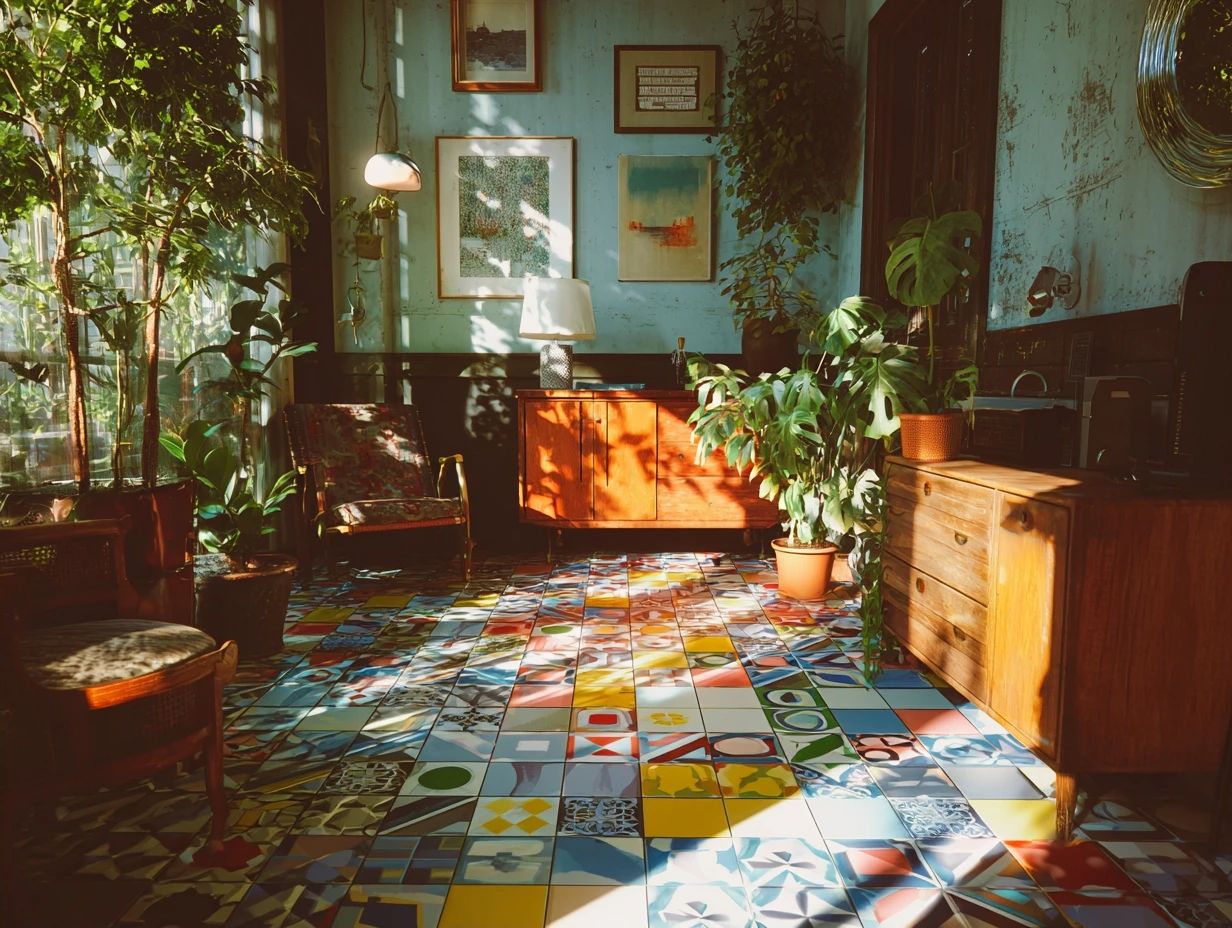
The Revival of Retro Flooring Trends highlights the growing appreciation for vintage-style flooring, reflecting nostalgic design preferences that blend classic aesthetics with modern functionality. Even though the given information lacks exact figures or data sets, there are important points to think about when looking at the comeback of old-style flooring in modern home design.
Retro flooring Choices like parquet, terrazzo, and patterned tiles are becoming popular as homeowners and designers look for unique and lasting styles that remind them of past times. This revival is driven by a desire for individuality and a return to the artisanal quality often seen in flooring designs of the past.
- Parquet Flooring: Parquet flooring is recognized for its detailed wood patterns and geometric designs, giving it a stylish and refined look. Today’s models often combine traditional skills with eco-friendly materials, attracting consumers who care about the environment.
- Terrazzo Flooring: Popular in mid-century modern design, terrazzo features chips of marble, quartz, and glass embedded into cement. Its strong build and ability to change colors make it a great choice for homes and businesses.
- Patterned Tiles: Designs using vibrant and strong colors, similar to Victorian or Art Deco styles, are becoming popular again. These tiles add character and visual interest, serving as focal points in bathrooms, kitchens, and entryways.
The revival of these retro flooring trends reflects broader design movements that prioritize personalization and historical appreciation. Consumers are increasingly drawn to styles that offer a sense of nostalgia while allowing for creative expression within modern contexts.
Although we don’t have exact data, it’s clear that retro flooring styles are making a comeback. People are choosing designs that express their unique taste and classic looks. Industry professionals can address consumer preferences by balancing appreciation for the past with current needs.
Vinyl Flooring Resurgence
Vinyl flooring, particularly luxury vinyl tiles (LVT), is gaining popularity due to its versatility, affordability, and extensive design options at retailers like Flooring Superstore.
Actually, the LVT market has grown by more than 40% in the past five years, thanks to new designs that copy the look of wood and stone.
Homeowners increasingly favor LVT for its ease of installation; many opt for the click-lock method, allowing for DIY projects that save on labor costs.
Current design trends feature herringbone patterns and bright colors, attracting modern tastes.
With the growing focus on sustainability, some brands offer LVT made from recycled materials, merging style with environmental consciousness.
Carpet Tiles and Shag Carpets
Carpet tiles and shag carpets are becoming popular again because they feel nice, are cozy, and let people design unique spaces in homes and offices.
These flooring options add both practicality and a touch of nostalgia to modern design.
For example, a lively combination of patterned carpet tiles can mark different areas in an open office, encouraging teamwork while allowing personal style. Meanwhile, shag carpets bring warmth and softness to living rooms, creating inviting areas for relaxation.
Brands such as FLOR provide carpet tiles that you can change individually if they get damaged, which makes them a sensible option for busy places. Successful installations often feature strong color choices that improve the decor, combining practical use with pleasing looks.
Terrazzo Flooring Revival
Terrazzo flooring is gaining popularity again as designers use its geometric patterns and vintage appeal in homes and businesses.
This trend is largely driven by its sustainability, as terrazzo is commonly made from recycled materials like glass and stone.
Its flexible style offers many design options; for example, a modern kitchen might have large, eye-catching patterns, while a minimalist office could use soft colors.
Innovative approaches include using terrazzo in furniture, such as custom tabletops or accent walls, blending classic elegance with contemporary style.
The result is a lively flooring choice that attracts environmentally aware buyers and fans of design.
Linoleum as a Modern Choice
Linoleum is re-emerging as a modern flooring choice, celebrated for its eco-friendliness and ability to define spaces in various interior styles.
Manufacturers have responded to the resurgence by offering linoleum in a wider palette of colors and patterns, appealing to contemporary aesthetics. Sales of linoleum have increased by 20% in the last two years, indicating its growing popularity.
People who care about the environment like that linoleum is made from natural materials such as linseed oil, cork dust, and wood flour, which means it can break down naturally. Companies like Forbo and Marmoleum highlight sustainability through innovative designs that mimic natural elements, allowing for stylish yet environmentally responsible choices in residential and commercial spaces.
Color Palettes and Patterns
Color schemes and designs are key to retro flooring, with bright colors and geometric shapes being the main features that make interiors stand out. For those interested in the latest trends, the 2025 Flooring Trends offer insights into how colors, materials, and patterns are evolving.
Bold Colors from the Past
Strong colors such as deep reds and bright greens, which were popular in the past, are becoming fashionable again in flooring, particularly in designs with a lot of detail.
These colors can greatly change a room. For example, a deep burgundy or emerald green wood floor can be a striking feature in a living room, paired with neutral walls and bright artwork.
Modern homes often use these colors in tile, where detailed patterns in deep colors add character to entryways or kitchens. Brands like Shaw Floors offer options like the `Garnet Oak’ or `Hunter Green’ tiles, which can be combined with lighter decor to balance the visual impact while maintaining a contemporary feel.
Geometric Patterns and Textures
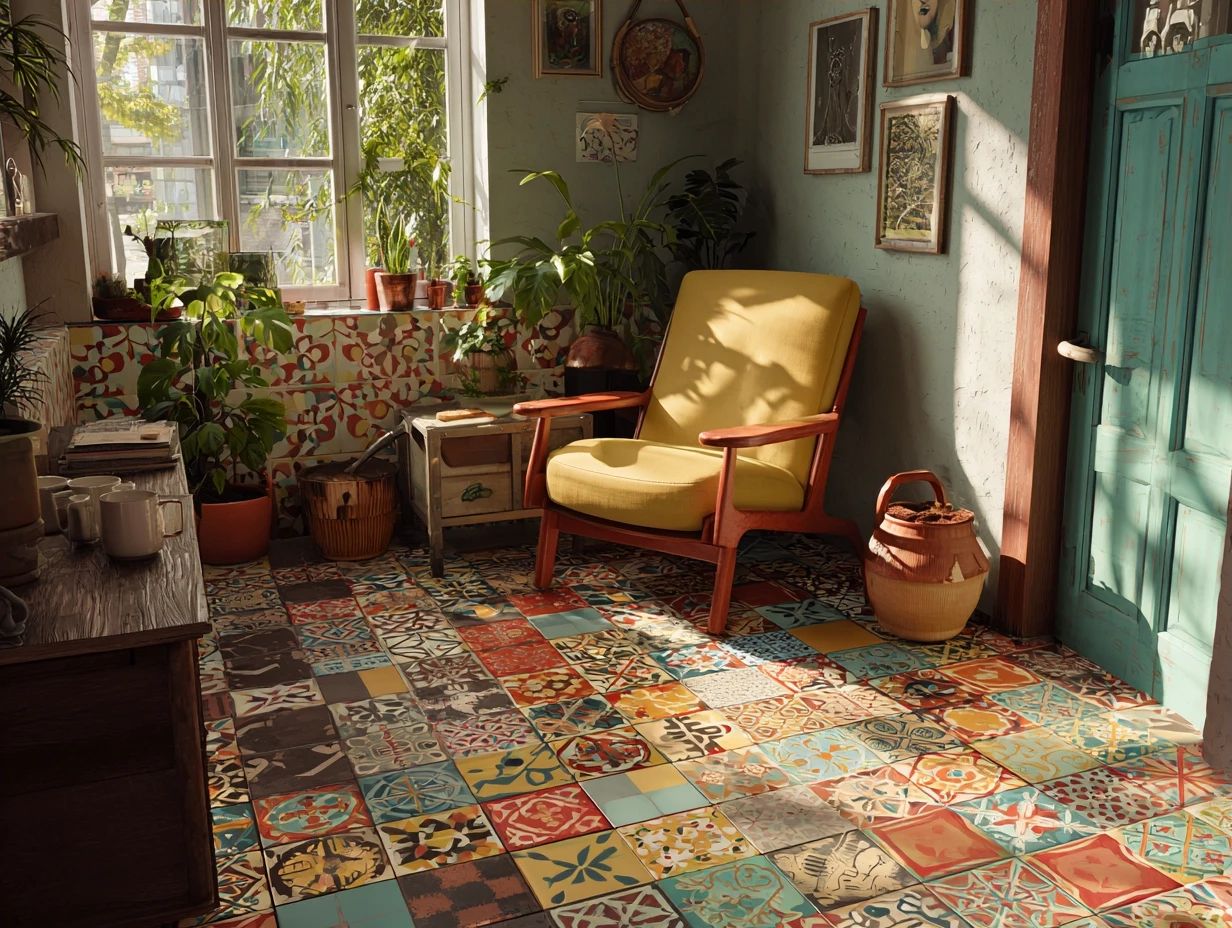
Geometric shapes and textures, like checkerboard tiles and hexagon designs, play a key role in creating a retro look that fits well with modern styles.
To use these patterns well, think about choosing retro-style vinyl flooring with bright colors or ceramic tiles that look like old-fashioned designs.
For instance, a classic black-and-white checkerboard in an entryway creates a striking visual impact, while colorful hexagonal tiles in a kitchen can add warmth and personality.
Brands like Hexagon Tiles offer customizable options, allowing you to mix and match colors for a unique design. Utilizing area rugs with geometric prints can soften the look while staying true to the retro theme.
Materials and Sustainability
Choosing materials and ensuring sustainability are important in retro flooring.
Focus on eco-friendly options and strong vintage materials. As mentioned in our discussion on eco-friendly flooring trends, selecting sustainable options can significantly enhance both the aesthetic and environmental value of your flooring project.
Eco-Friendly Options in Retro Flooring
Eco-friendly options in retro flooring, like bamboo and reclaimed wood, provide sustainable alternatives that align with contemporary design preferences.
Bamboo flooring is sustainable and durable, making it a good choice for high-traffic areas.
Reclaimed wood, on the other hand, recycles existing materials, offering unique character while reducing waste. Both types have gained popularity, with studies showing that 70% of consumers prefer products made from sustainable materials.
Cork flooring offers natural insulation and hypoallergenic properties. Choosing these eco-friendly options improves interior design and shows a commitment to sustainability, attracting more environmentally-aware buyers.
Durability of Vintage Materials
The durability of vintage materials, such as original wood flooring and terrazzo, showcases their lasting appeal and value in modern design.
These materials last a long time and help save money while being environmentally friendly. Original wood flooring, often reclaimed from old buildings, can last for generations when properly maintained.
Terrazzo, constructed from marble and glass pieces, is stain-resistant and durable, which makes it a popular option for busy areas. Utilizing these materials reduces the need for frequent replacements, minimizing waste.
Vintage fixtures like cast iron bathtubs also exemplify durability; many are still in use today, adding charm and character to contemporary homes.
Installation and Maintenance Tips
Putting in and looking after retro flooring are important for it to last a long time.
Following specific advice helps keep its appearance and usability intact.
DIY vs. Professional Installation
Choosing between DIY and professional installation for retro flooring can significantly impact both the outcome and overall costs involved.
Opting for DIY can save money, typically costing around $2 to $3 per square foot in materials alone. This method is effective if you have basic carpentry skills and can spend time on detailed tasks.
Required tools may include:
- a jigsaw
- a measuring tape
- adhesive
Professional installation usually costs between $5 and $10 per square foot. Paying for experienced workers means the tiles will be correctly placed and finished. For those looking for a flawless look but short on time, hiring a pro is a wise choice, even considering the higher upfront cost.
Cleaning and Care for Retro Floors
Regular cleaning and proper care are essential for maintaining the beauty and integrity of retro floors, ensuring they last for years.
To keep your retro flooring in top condition, consider these specific cleaning and maintenance tips.
- For vinyl floors, use a pH-neutral cleaner like Armstrong Once ‘n Done, which effectively removes dirt without damaging the surface.
- For old tiles, a gentle scrub with water and vinegar can restore shine without harsh chemicals.
- To maintain wood floors, apply a durable wax such as Minwax Paste Finishing Wax every few months.
Always sweep or vacuum regularly to avoid grit buildup, which can scratch surfaces over time.
Incorporating Retro Flooring in Modern Spaces
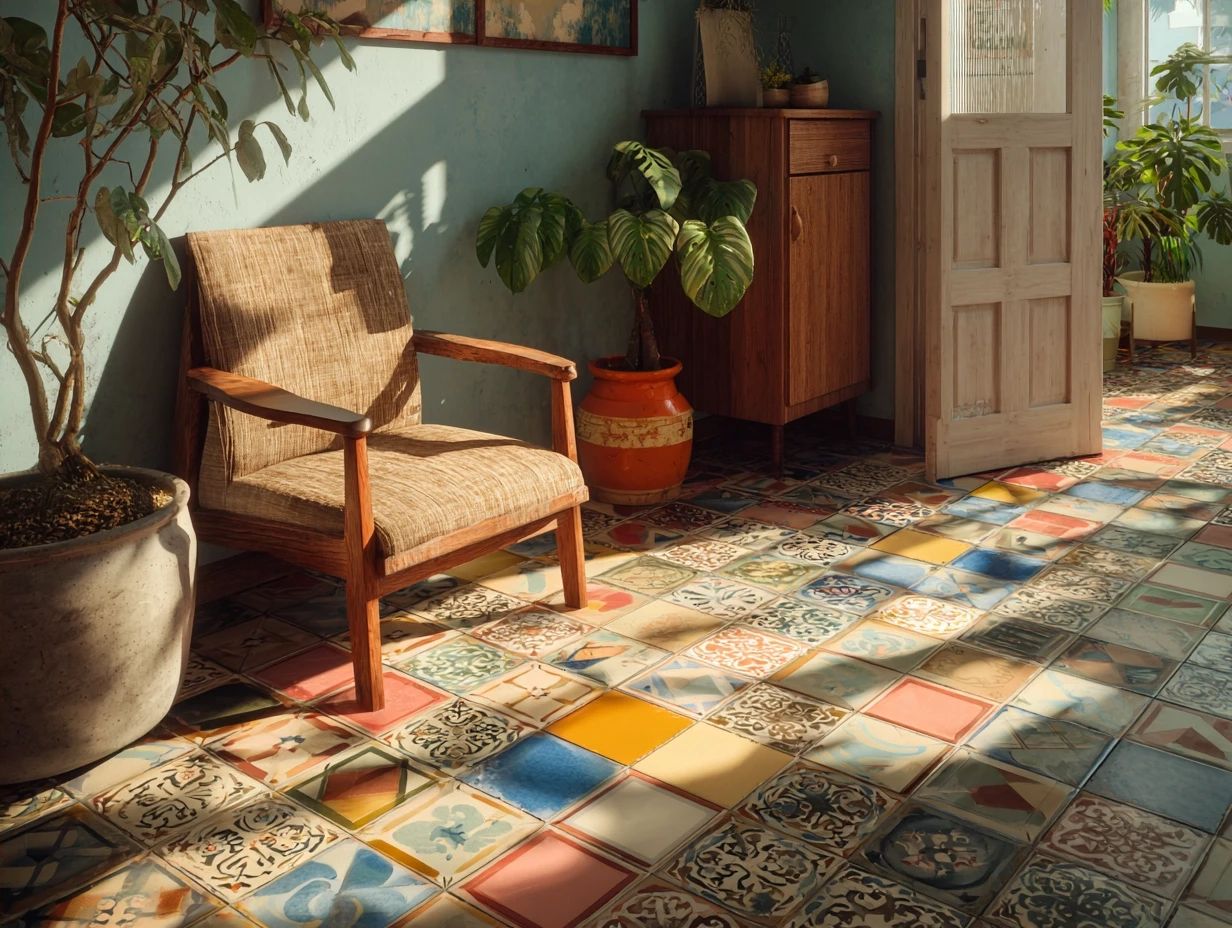
Adding retro flooring to modern spaces gives a special look that combines old and new styles, giving any room more character.
Blending Retro with Contemporary Design
Blending retro flooring with contemporary design can create impactful interiors where vintage charm meets modern sensibilities.
To achieve a cohesive look, consider pairing mid-century tile or laminate flooring with sleek, minimalist furniture. For example, a beautifully patterned 1960s vinyl floor pairs seamlessly with a white Scandinavian dining table.
Adding retro-style light fixtures can improve the vintage feel of this space. Tools like Pinterest can help you see different mix and match ideas, while apps such as Houzz let you look at real-world examples.
By carefully selecting complementary elements, you can create a unique atmosphere that celebrates both eras beautifully.
Room-Specific Flooring Ideas
Each room offers different ways to install retro flooring, with ideas that improve how the space works and looks.
In kitchens, consider checkerboard-patterned vinyl tiles, which offer durability and ease of cleaning while adding a playful touch.
For living rooms, choose rich hardwood with a worn look or carpets with strong patterns to create a vintage atmosphere and coziness.
Bedrooms can benefit from soft, shaggy rugs or classic linoleum designs that create a nostalgic vibe.
When choosing retro flooring, prioritize materials that withstand daily wear and still reflect the room’s personality, ensuring style meets practicality throughout your home.
Frequently Asked Questions
What is retro flooring?
Retro flooring describes flooring styles from earlier times that are becoming popular again in today’s home design. Imagine eye-catching patterns, lively colors, and distinctive textures that were in style during the 1950s, 60s, and 70s.
What are some popular retro flooring comebacks?
Some popular retro flooring comebacks include terrazzo, linoleum, and geometric patterns. These flooring options were popular in mid-century homes and are now being modernized and reintroduced into contemporary designs.
Why are retro flooring comebacks gaining popularity?
Retro flooring comebacks are gaining popularity because they offer a unique and nostalgic touch to modern home designs. They give a space its own unique look, making it different from the common designs seen today.
Can retro flooring fit into any home style?
Yes, retro flooring can fit into any home design. It is a design element that works well with various styles, from mid-century modern to eclectic bohemian looks.
How durable is retro flooring?
Retro flooring can be extremely durable, depending on the material and installation method. For example, terrazzo and linoleum are known for their durability and can last for decades with proper care and maintenance.
Are retro flooring comebacks budget-friendly?
Retro flooring comebacks can be budget-friendly, especially when compared to high-end, modern flooring options. Some old-fashioned flooring options, such as linoleum, are both environmentally friendly and affordable, making them an excellent option for homeowners mindful of their budget.
